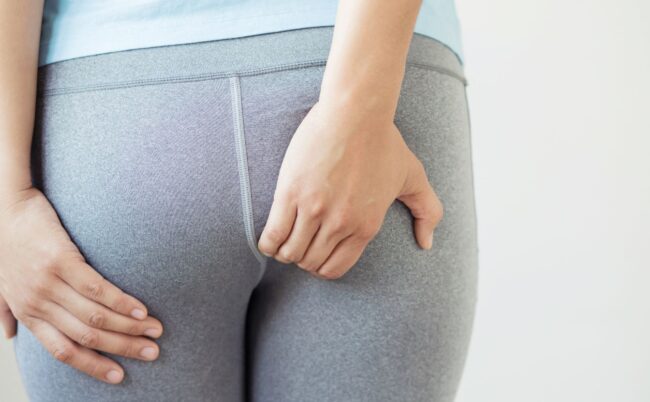Prolapse. A word that looks like it was borrowed from a Harry Potter spell! Far from being magical, it hides a reality that is often ignored: either because we don't want to see it, or simply because we is not aware of this pathology. To protect yourself and understand everything about anal prolapse, Let us look at the avenues available to us.
Detecting anal prolapse
To fight your enemy, you must know him. A mantra drawn from The Art of War, which applies well to the opposing duel women with prolapse. Between 11 to 19% of them are likely to be confronted with this health problem during their life.
So, what exactly are we talking about? From a organ descent, as is commonly called prolapse. This manifests itself in the downward sagging of the organs of the pelvic area (the bladder, the rectum and, more rarely, the uterus).
The different types of prolapse
There are different types of prolapse depending on the organ involved. We then talk about:
- rectocele for descent of the rectum;
- Hysterocele for a descent of the uterus;
- cystocele for bladder descent.

When the prolapse descends through the anus, we speak of anal prolapse. Concretely, one or more genital organs literally come out of the body through the anus (usually the rectum).
Likewise, prolapse can also be vaginal when the organs slide through the vagina. Vaginal and anal prolapse are two separate conditions but can have similar symptoms of organ descent.
When can you suffer from anal prolapse?
Anal prolapse can occur during different stages of a woman’s life. This is particularly true regarding multiparous mothers, for physiological reasons of putting the internal organs to the test by the successive pregnancies.

Same for the menopausal women, this time for hormonal reasons of pelvic floor relaxation. In the event of anal prolapse, the pelvic floor muscles that support the rectum will weaken, leading to feeling of pressure or descent.
Some sports practices with high gravitational impact add a risk factor, in the same way as dietary deficiencies, obesity, complicated childbirth.
A surgical operation having been performed in this region of the body is also sometimes causing prolapse.

What are the symptoms of anal prolapse?
Symptoms of a possible prolapse are: discomfort in the lower abdomen, a feeling of pelvic floor gravity, or even to have like a lump in vagina.
We sometimes witness urination problems (urinating with a discontinuous stream for example) or, in the most serious cases, a pain, sometimes synonymous with exteriorization of the organ.

What tests to detect a prolapse?
Beyond these warning signs, a gynecological examination allows the diagnosis to be made with certainty. A complementary vaginal examination, sometimes a rectal examination, make it possible to estimate the level of severity of the prolapse.

According to the resulting conclusions, a urodynamic assessment may be prescribed to the patient, so as to prevent urinary incontinence concomitant with the correction of the prolapse.
Analyse d’urine et IRM are also included in the list of medical examinations potentially leading to surgery, when Conservative measures are not enough.
Prevent, alleviate or cure anal prolapse
Strengthen your perineum to prevent prolapse
To reduce, upstream, the threat of prolapse, it is a matter of work your perineum. Ladies, let's trust our famous "hammock".

Thanks to a toning this set of muscles which retain the pelvic organs, we have, logically, a greater chance that they will remain in the original place that nature assigned to them.
For this, you can call on a health practitioner, or to a masseur-physiotherapist specialized in pelvi-perineology.
Visualization techniques for the perineum
Furthermore, it is possible to exercise your perineum by practicing visualization methods, like the cave and drawbridge technique, aimed at representing the opening and closing movements of our vagina.
This option offers the advantage of being at home without requiring any equipment, but still has its limits.
Tone your perineum with the Emy probe to fight against prolapse
Another alternative to practice at home : perineal rehabilitation with probe connected. Performed using the Emy probe, which is based on the principle biofeedback, this type of rehabilitation involves the woman contracting her perineum.

The probe serves as a sensor that detects the‘muscular effort and sends a signal to the associated mobile application to see contractions in real time. Enough to make rockets take off with your perineum, no less!
In fact, the application offers different universes for training, fun or more medical. And the exercises are actually based on medical protocols which are offered in the form of around thirty games.
Learn more about the Emy probe
Adapt your lifestyle
This perineal rehabilitation is also good to practice if the prolapse is already there, but it is not neither too settled nor too serious. Rehabilitation then allows the patient to avoid complications.
We will associate these efforts with that of a weight loss when there is excess weight, as well as the adjustment of its sports practices, to favor the gentle sports for the pelvic floor, like swimming.
Other alternatives to manage your anal prolapse
Wear a pessary
In addition to these lifestyle changes, we can turn to a medical boost: the pessary.
This device has the role of compensate for perineal weakness but its intravaginal positioning can be inconvenient for long-term use and it is generally recommended as transitional solution.

Applying strips
To manually put the organs impacted by a prolapse back into place, there is the so-called operating method. strips, which are positioned on the woman's organs via a abdominal surgery.
More rarely, the health practitioner chooses to position a prosthesis vaginally. Either a urologist or an obstetric surgeon can perform these two types of operation.
More common than we think, anal prolapse sometimes takes time to appear with identifiable symptoms. So be, as much as possible, regular in your annual meetings to your healthcare professional. The best monitoring in this area remains listening to your body and what can abnormally change from the ordinary.




